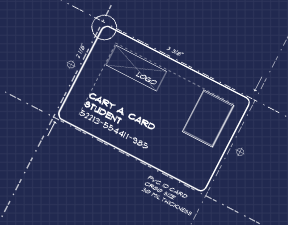Creating an ID program from the ground up
Launching a brand new campus card program isn’t as easy as signing a contract and cutting a check. There are many steps a schools needs to go through before they even choose a vendor.
CR80News asked questions to campus card vendors asking what a school would have to do if starting a campus card program from scratch. The questions ranged from how much an existing IT infrastructure impacts system selection, to what needs to be budgeted beyond the vendor contract amount to upgrade existing networks and how a campus card office should be staffed.
Vendors were hesitant to talk dollar figures for a new system as costs can go beyond the contract with the campus card vendor. Software and IT networks may have to be upgraded, an expenditure that could potentially be more than the contract with the campus card vendor depending on the size and scope of the project.
But at the same time an institution can reap rewards. Significant cost savings and even new revenue streams are attainable. “We review with them areas where they can make money back and do an ROI based on the scope of the project,” says Fred Emery, vice president and general manager at Heartland Campus Solutions.
And then there are the very real benefits–such as increased security–that are difficult to quantify. “Can you put a price on the security of students,” asks Emery. “Just having a safe environment is a prime driver for educational institutions and it’s hard to do an ROI on that.”
Systems also automate previously manual tasks, says Read Winkelman, vice president of sales at the CBORD Group. “There are many soft costs in a manual operation that may not be so evident,” he says, “so a true (cost) comparison may be difficult.”
But there are other items to take into account when it comes to cost, Winkelman says. “There are key indicators that can be used to benchmark the cost over time–deposits on hand, increase in meal plan sign ups, reduction of lost keys,” he says. “Taken with the hard costs of hardware, software, implementation and staffing, it is possible to determine the cost, or benefit, of a campus card system.”
In the beginning …
Before even looking for vendors a university should figure out what they want the ID card to do and then take stock of the different systems that could be impacted by those applications, says Tom Bell, vice president of industry relations at Blackboard.
Point-of sale systems in the dining halls and book stores, print and copy services, student information systems, personnel systems and physical access control systems are just a few of systems that could be impacted with a campus card.
Bell says most campuses don’t realize the array of different systems impacted by an ID card. “I’ve been on campuses the last year where there are three or four different access control systems,” he says. “This creates an interesting challenge for the campus and those supporting it.”
During the inventory process the institution should name a point person to oversee the deployment, says Emery. “We recommend that there is one person who is the project liaison,” he says.
While a single point person is recommended, various tasks can be farmed out to other college offices, Emery says. For example, security can pull certain reports and housing can address different access control rules “We try to separate functions to different campus business entities so personnel can manage tasks,” he says.
This cross-campus involvement is important for managing the workload but also ensuring ultimate buy-in. While there should be one point person it’s important to get others around campus involved, says Jay Summerall, president at CardSmith.
“Key stakeholders need to be included, such as dining service operators, bookstore managers, vending and laundry contractors,” he says. “The card program will affect how these auxiliaries operate, so it’s important that they understand how it works and their part in the process. Library and public safety personnel also need to be included because the card’s encoding may affect their operations. Business or Finance offices too, because the card program will involve funds transfers, accounting and reconciliation.”
During the vendor selection process the campus card provider will work with the school to figure out its goals and what systems to deploy, Emery says. Some institutions may only want physical access control and meals plans while others may also want printing/copying and vending, laundry and an off-campus program.
The feature set lays the groundwork for assessing a school’s IT infrastructure and whether or not upgrades are required. Upgrading a network can be the largest cost associated with a campus card system, Bell says. “Pulling wire is an expensive thing,” he says.
A new physical access control system often requires new locking mechanisms and card readers. This can be problematic in some environments, Bell says. He points to Duke University’s historic buildings with stone walls and elaborate doorways. Making changes to such facilities can be difficult, expensive or even prohibited by architectural code.
Even devices that run on wireless networks can still require mechanical changes to be made.
New staff?
Another cost to keep in mind is the real estate and staffing for the campus card office. Vendors agree that the card office must be in a central location so students can have easy access. Staffing can be a bit more difficult to figure out and is one of the more pressing questions confronting new programs.
Winkelman says it depends on the size of the program and the amount of help from other departments. “Generally a card office would need at least one full-time campus card system administrator and one back-up that is at least half time,” he says. “So, one and a half to two full-time equivalents to begin with.”
There are other options for staffing models, says Brian Adoff, national sales manager at NuVision Networks. He offers three different staffing models: the IT department model, the card office model and the auxiliary services model.
The IT model is for smaller schools and community colleges that have an IT infrastructure but not necessarily a dedicated OneCard department. “In some schools it is one person from IT or sometimes it’s the whole IT department that shares the responsibilities,” Adoff says. “They are generally responsible for maintaining hardware, servers and programs, and providing assistance to users.”
In this model the individual departments–dining services, bookstore, housing–are responsible for administering their piece of the program. This IT department model works best with a strong, communicative campus card committee, Adoff says.
The card office model employs a card office manager and potentially clerical help, Adoff says. This model makes the card office responsible for data flow, ID production and support for departments using the system. As with the IT model, individual departments are still responsible for their items though a dedicated resource is available for support. In the card office there is a strong financial focus for self-sustainability and revenue generation.
The most involved model is the auxiliary services model in which the card program operates as a standalone business unit. It typically employs a director, assistant director and administrative support, Adoff says. Auxiliary services is financial-based and responsible for all parts of the operation. This includes: data flow, card office, dining services, bookstore, vending, off campus, parking. Adoff stresses that this model is not appropriate in all cases, but he has found that total control of the card program in one office typically enables quicker, cohesive expansion of the program.
CardSmith employs a software as a service model designed to limit the staffing and infrastructure requirements on the campus. Summerall says one employee is typically necessary but there is no need for a system or database administrator in their environment. “Card production and basic customer service can be provided by an issuing office such as the Public Safety Office or a ‘one stop shop’ that supports other campus operations,” Summerall says.
But depending on the size or scope of a project a dedicated manager can be beneficial. “If the program scales large enough, a small, dedicated card office can also make sense,” Summerall says.
 Card technology
Card technology
While magnetic stripe has been defacto ID technology on campus for years contactless smart cards are making inroads to the campus market. The system vendors should work with the institution to determine the technology or technologies best suited for the specific situation.
Technology selection again hinges on what the campus wants to do with the card, vendors agree. “It’s very important to educate (the campus decision makers) on available technologies so they understand their options,” Blackboard’s Bell says.
Deployment
So the inventory has been done, the project scoped, a vendor selected and wire pulled. It is time to deploy but the question is when to rollout the new system?
“Most programs launch over the summer; that’s never a bad idea,” Summerall says. “But it certainly can be done at winter break with proper planning.”
Others disagree with the preference for summer rollouts.
Bell says summer is the worst time to deploy a campus card system. “I was on a campus for 30-years and I understand the drive to do everything in the summer but it’s wrong,” he says.
Staff vacations, competing projects and rushed deadlines are all obstacles to overcome trying to deploy a new system during the summer, Bell says. Starting a deployment at the beginning of a fall semester works well, Bell has found. “The most staff is around, it helps with training and understanding what’s going on,” he says.
NuVision’s Adoff says that a mid-semester launch can work just as well. “All of the campus staff is present and there is actual student data to practice with,” he says.
As for the length of time that it will take to deploy a new system, it seems there is no perfect answer. Vendors say it varies depending on the size and scope of the system, and estimates range from eight to 12 weeks.
Lessons learned
There are precautions institutions can take to minimize problems during the rollout.
Figure out the scope of the project and don’t go overboard, Winkelman says. “Involve key stakeholder departments in the planning, even if they won’t have much of a role in the initial deployment,” he says. “It’s important that they are on board from the beginning. In determining initial applications for rollout, talk to students and see what they want. They probably have some great ideas that you may not have considered.”
Getting the word out about the program to students is also important, says Heartland’s Emery. “You need to have the resources set aside and make sure marketing is in place so students know about the program,” he says.
Having the administration involved with this helps, says Winkelman. “The president of the college or university should have a card, and use it frequently and visibly,” he says. “That will show the campus’ commitment to the program and have a major impact on success.”
Schools need to make sure to identify who will be in overseeing the card program from the start,” says Summerall. “The biggest mistake from our perspective, is not identifying an owner for the card program, and a clear set of priorities,” he says. “Without an effective management model, the program will underperform its potential.”
And don’t forget to budget for ongoing recurring costs. “Buying a system to last forever won’t work,” says Bell. Hardware and software will require upgrades just like every other critical IT system.



